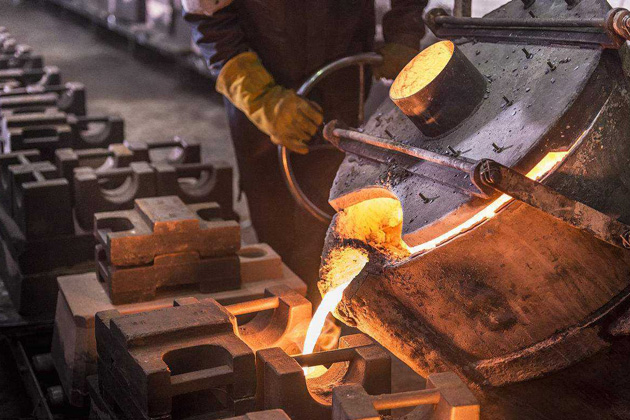Why Aluminum Foundry Wisconsin empowers casting businesses
Wiki Article
Exactly How Aluminum Foundry Contributes to Developments in Aerospace Engineering
Aluminum shops are integral to improvements in aerospace engineering. They create lightweight, high-strength parts that are necessary for contemporary airplane. With advanced casting strategies, these foundries produce complicated geometries that enhance structural stability. Additionally, the development of superior Aluminum alloys sustains the market's concentrate on fuel performance and sustainability. Obstacles remain in the production procedure. Comprehending these variables reveals the profound influence of Aluminum on aeronautics's future.The Importance of Lightweight Products in Aerospace Design
As the aerospace market remains to progress, the value of lightweight products ends up being progressively noticeable. The need for performance and sustainability drives engineers to prioritize using products that minimize general weight without endangering structural honesty. Light-weight materials, specifically Aluminum, play an essential role in boosting gas efficiency, boosting haul capacity, and increasing the general performance of aircraft.Additionally, the assimilation of these materials enables for ingenious designs, making it possible for makers to develop even more wind resistant forms that can withstand extreme conditions. The reduction in weight not just decreases functional prices but likewise adds to a decreased ecological footprint, aligning with global efforts toward sustainability in aviation.
Advanced Spreading Techniques in Aluminum Foundries
Advanced casting methods in Aluminum foundries play a vital duty in aerospace design by allowing the production of specific and lightweight components. Technologies in mold design and accuracy spreading procedures are important in achieving excellent performance and structural integrity. In addition, the advancement of light-weight alloys improves the total effectiveness and efficiency of aerospace applications.Cutting-edge Mold Style
Innovative mold and mildew style plays a crucial role in the performance and performance of Aluminum foundries, specifically within the aerospace industry. By leveraging sophisticated products and strategies, contemporary molds can be engineered to stand up to high temperatures and stress, making certain peak performance throughout the casting procedure. These styles often incorporate intricate geometries that allow for the production of light-weight yet structurally sound parts, essential for aerospace applications. In addition, using computer-aided layout (CAD) software program helps with exact modeling, making it possible for factories to refine and mimic mold and mildew layouts prior to physical production starts. This not just boosts the quality of actors parts however additionally lowers waste and lead times, resulting in considerable expense savings. On the whole, innovative mold and mildew layout is a cornerstone of progression in Aluminum Foundry technology for aerospace design.Accuracy Casting Procedures
The effectiveness of innovative mold layouts seamlessly integrates with accuracy spreading procedures, which are important for generating top quality Aluminum elements in aerospace engineering. These procedures, consisting of sand spreading, pass away spreading, and financial investment spreading, guarantee the development of intricate geometries with tight tolerances. Advanced methods like vacuum spreading and stress pass away casting boost the integrity and surface finish of the end products. Precision spreading decreases material waste while taking full advantage of the mechanical properties of Aluminum, important for aerospace applications. Additionally, utilizing real-time surveillance and advanced simulation devices throughout the casting procedure enables instant changes, causing boosted high quality control. Jointly, these precision spreading procedures placement Aluminum factories at the forefront of aerospace innovation, sustaining the market's demand for reliability and performance.Lightweight Alloy Advancement
As aerospace engineers seek to improve fuel effectiveness and efficiency, lightweight alloy development ends up being a crucial emphasis in Aluminum factories. These foundries use innovative casting methods to create alloys that give exceptional strength-to-weight ratios. Advancements in alloy composition, consisting of the incorporation of aspects like lithium and magnesium, allow the manufacturing of products that withstand extreme conditions while lowering general airplane weight. Techniques such as die spreading and financial investment spreading assist in the accuracy manufacturing of intricate shapes, which are essential for aerospace applications. In addition, ongoing research study intends to optimize these alloys for boosted mechanical residential or commercial properties and raised durability. By focusing on lightweight alloy growth, Aluminum shops substantially add to the development of aerospace engineering, leading the way for extra lasting and effective airplane layouts.
Enhancing Architectural Honesty Through Aluminum Elements
Aluminum elements supply significant benefits in boosting architectural stability within aerospace design. Their lightweight nature adds to general efficiency while maintaining toughness, which is vital for airplane performance. Additionally, the stress and anxiety resistance residential or commercial properties of Aluminum assistance guarantee the toughness and integrity of aerospace frameworks under different operational conditions.
Lightweight Product Perks
While conventional products usually endanger weight for strength, using Aluminum parts in aerospace engineering offers significant advantages in architectural honesty. Aluminum's lightweight nature adds to total layout performance, enabling more structured aircraft that take in much less gas, therefore boosting sustainability. The material's superb strength-to-weight ratio warranties that components maintain durability without including unnecessary mass. This quality fosters improved performance and dexterity in trip, along with maximized payload abilities. In addition, Aluminum's resistance to deterioration extends the lifespan of aerospace structures, minimizing maintenance prices and improving safety. As makers significantly adopt Aluminum alloys, the aerospace market experiences a transformative shift towards a lot more reliable and effective design options that focus on both efficiency and ecological obligation.Anxiety Resistance Properties
Although different products possess unique residential properties, Aluminum's exceptional anxiety resistance stands apart as a crucial aspect in improving the structural stability of aerospace parts. This resistance plays a vital function in making certain that airplane can hold up against various operational tensions, including tiredness, effect, and ecological problems. Aluminum alloys, particularly crafted for aerospace applications, show high tensile toughness while keeping lightweight attributes, enabling designers to develop a lot more reliable structures - Aluminum Foundry. Additionally, the ability of Aluminum to withstand cyclic loading without substantial contortion adds to the long life and integrity of aerospace elements. As innovations proceed in Aluminum Foundry methods, the advancement of stress-resistant Aluminum elements promises further improvements in performance, security, and efficiency across the aerospace sector, strengthening Aluminum's function as a preferred material in modern designFuel Efficiency Improvements Driven by Aluminum Innovations
As the aerospace sector looks for to improve fuel efficiency, cutting-edge uses Aluminum have actually become a necessary option. Aluminum's lightweight nature significantly minimizes aircraft weight, enabling lower fuel usage throughout trip. This reduction in weight is crucial, as even little reductions can lead to considerable improvements in general gas economy.Advanced Aluminum alloys, developed for enhanced strength and resilience, allow suppliers to create components that preserve architectural stability while minimizing mass - Aluminum Foundry. In addition, the combination of Aluminum in airframes and engine parts promotes enhanced the rules of aerodynamics, contributing to minimized drag and enhanced performance
The adoption of Aluminum in aerospace not just fulfills the demand for fuel-efficient design but likewise straightens with regulative pressures for reduced emissions. As these innovations remain to advance, they play a significant function in establishing new criteria for gas efficiency, ensuring that the aerospace field can satisfy growing financial and ecological obstacles.

The Role of Aluminum in Sustainable Air Travel Practices
The boosting emphasis on lasting air travel techniques has actually placed Aluminum as a crucial material in the mission for greener aircraft style. Understood for its lightweight homes, Aluminum significantly lowers airplane weight, causing reduced gas usage and discharges. Its recyclability even more improves its sustainability profile, as Aluminum can be recycled forever without loss of quality. This particular sustains a round economic situation within the aeronautics sector, minimizing waste and resource depletion.Advancements in Aluminum alloys have actually boosted their stamina and rust resistance, permitting for longer solution life and decreased upkeep demands. These advancements promote the growth of much more efficient airplane frameworks, adding to overall sustainability initiatives. In addition, Aluminum's thermal conductivity plays an essential duty in energy-efficient layouts, enhancing systems such as warmth exchangers. Jointly, these attributes highlight Aluminum's pivotal role beforehand sustainable aviation, straightening with worldwide campaigns targeted at decreasing the environmental effect of air traveling.
Challenges Faced by Aluminum Foundries in Aerospace Production
While Aluminum shops play a necessary function in aerospace manufacturing, they face considerable obstacles that can influence production effectiveness and high quality. One major challenge is the strict quality assurance standards called for in the aerospace market. Any kind of defect can jeopardize safety and performance, read this requiring strenuous assessment procedures that prolong manufacturing timelines. Additionally, foundries commonly contend with changing resources expenses, which can influence pricing and profitability. The intricacy of Aluminum alloys made use of in aerospace applications further complicates the manufacturing process, as exact solutions are essential for attaining desired mechanical homes. Experienced labor lacks impede the ability to keep high-quality production degrees. Ecological policies impose restrictions on emissions and waste administration, calling for shops to invest in sustainable methods, which can be cost-prohibitive. These factors jointly produce a landscape where Aluminum factories must continuously adjust to satisfy the evolving needs of aerospace manufacturing while making sure safety and conformity.Future Fads in Aluminum Applications for Aerospace Engineering
With improvements in see this technology and boosting needs for efficiency, the future of Aluminum applications in aerospace design is positioned for considerable makeover. The integration of cutting-edge Aluminum alloys and composites is expected to improve strength-to-weight proportions, bring about more fuel-efficient aircraft layouts. Furthermore, innovations in additive manufacturing strategies will permit for the manufacturing of complicated Aluminum frameworks that were previously impossible, enhancing performance and minimizing waste.
Sustainable techniques will play an essential function, with a growing emphasis on recycling Aluminum to lessen ecological effect. The aerospace field is likely to welcome smarter producing processes, such as automation and expert system, guaranteeing better and precision in Aluminum components. Cooperations between Aluminum shops and aerospace firms will promote research study and development, leading the means for new applications that fulfill the rigorous demands of contemporary aerospace engineering. On the whole, the future looks guaranteeing for Aluminum's function in forming the skies
Often Asked Concerns
What Are the Ecological Impacts of Aluminum Production in Aerospace?
The ecological impacts of Aluminum manufacturing in aerospace include substantial power usage, greenhouse gas emissions, and habitat disruption. In addition, mining processes can bring about dirt deterioration and water contamination, increasing problems regarding sustainability and eco-friendly equilibrium.How Does Aluminum Contrast to Other Materials in Aerospace Applications?
Aluminum provides an unique mix of lightweight properties, deterioration resistance, and cost-effectiveness contrasted to other products. Its high strength-to-weight proportion makes it especially helpful for aerospace applications, enhancing gas effectiveness and overall efficiency in aircraft design.What Certifications Do Aluminum Foundry Employees Demand for Aerospace Projects?
Aluminum Foundry workers call for specialized training in metallurgy and spreading techniques, along with understanding of aerospace sector criteria. Accreditations in quality assurance and security methods are also vital to assure conformity with strict aerospace job demands.Are There Any Kind Of Security Interest In Using Aluminum in Aerospace Design?
Security issues concerning Aluminum in aerospace design include sensitivity to exhaustion, tension, and corrosion cracks. Correct therapy and alloy selection are vital to mitigate these threats, guaranteeing structural honesty and overall security in aerospace applications.How Does Aluminum Recycling Advantage the Aerospace Market?
Aluminum reusing significantly benefits the aerospace market by lowering product costs, decreasing ecological impact, and saving power. This lasting method boosts the industry's effectiveness while promoting the usage of light-weight, high-performance components in aircraft production.Advanced casting techniques in Aluminum foundries play a crucial duty in aerospace engineering by making it possible for the production of light-weight and precise elements. Cutting-edge mold layout plays an important duty in the efficiency and efficiency of Aluminum factories, particularly within the aerospace field. As aerospace engineers seek to improve gas efficiency and efficiency, light-weight alloy development ends up being a crucial focus in Aluminum shops. Aluminum alloys, especially engineered for aerospace applications, show high tensile strength while keeping light-weight attributes, making it possible for engineers to Learn More Here develop a lot more reliable structures. Partnerships in between Aluminum shops and aerospace business will certainly promote research and growth, paving the method for brand-new applications that fulfill the strict needs of contemporary aerospace design.
Report this wiki page